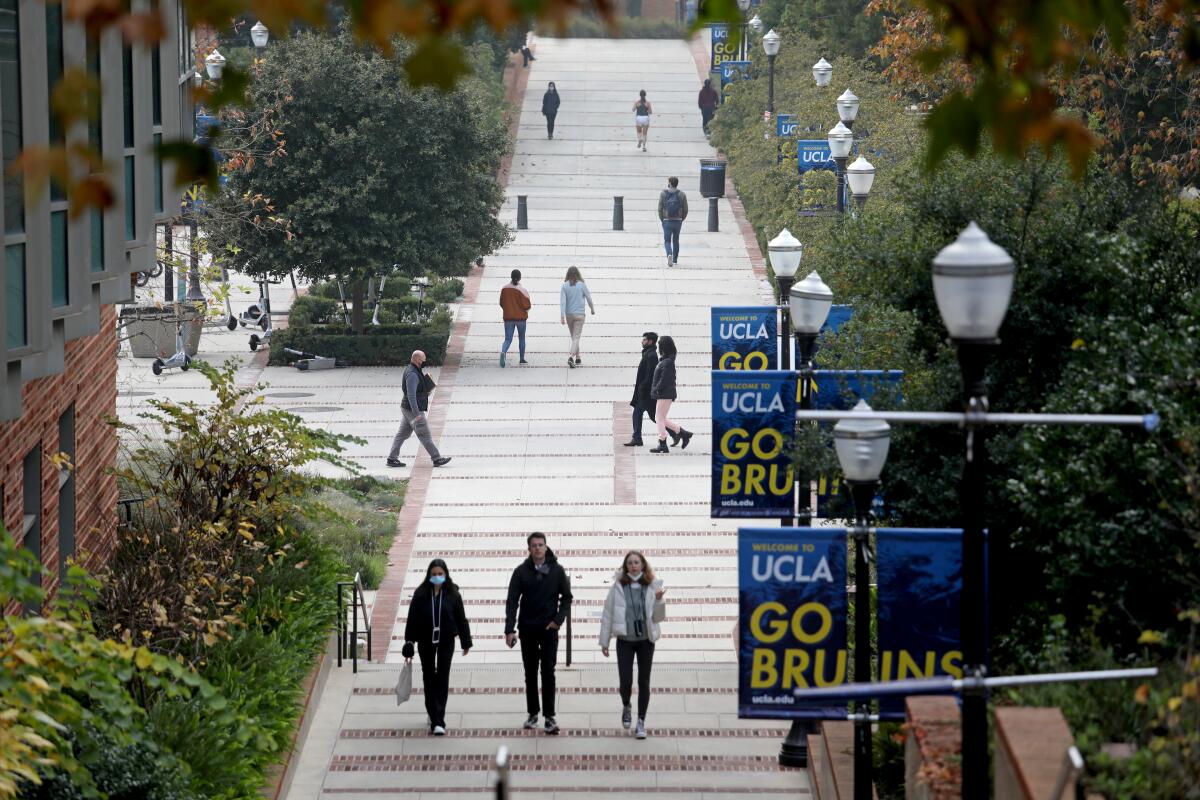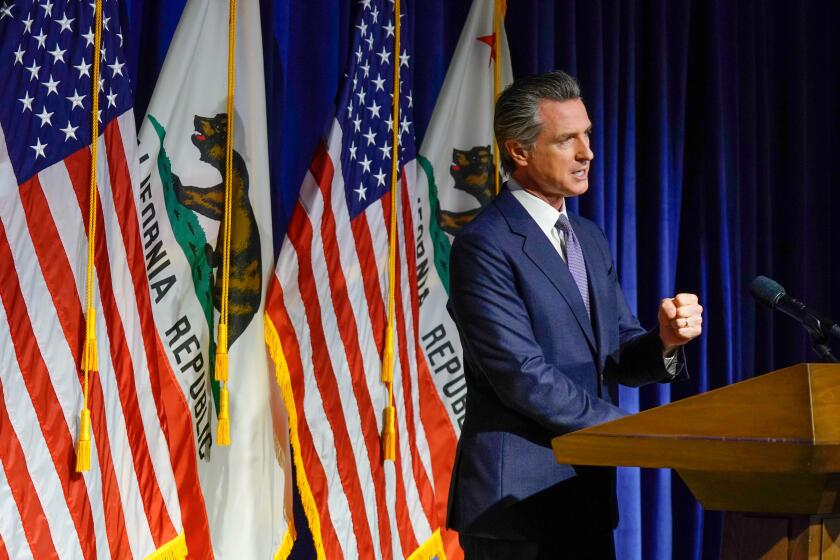Newsom proposes big funding for UC, Cal State. But there’s a condition: Close equity gaps

Gov. Gavin Newsom’s budget proposal released Monday makes a significant pledge to the University of California and California State University: five years of annual funding increases that would deliver long-sought financial stability.
But there’s also a big caveat. The public university systems have to close achievement gaps among underserved students, a stubbornly elusive goal for years, and meet a long list of other specific targets to boost graduation rates, reduce the cost of attendance and increase California undergraduate enrollment.
The budget plan also proposes funding to increase California student enrollment this fall by 9,434 students at Cal State and 7,132 at UC — including 902 seats at UCLA, UC Berkeley and UC San Diego currently allocated to international and out-of-state students. The state would provide $31 million to those three popular campuses to cover the cost of replacing nonresident students, who each pay about $30,000 in supplemental tuition, with Californians.
The multiyear agreements Newsom unveiled with UC and Cal State would provide a 5% base general fund increase for five straight years in exchange for commitments to expand access, equity, affordability and training for state workforce needs. The list of targets is longer and more prescriptive than those in previous agreements between governors and state universities. Former Gov. Jerry Brown, for instance, focused more generally on increasing transfer students, reducing costs and shortening the time to obtain a degree.
Additionally, roughly $1.6 billion is proposed for California’s 116 community colleges — the nation’s largest higher education system — linking funding to increasing the number of students transferring into UC and CSU, and a 20% hike in associate degrees, certificates or credentials by 2026.
“We have been working with our education partners, CSU, UC and Community Colleges, to see if we can come up with a new multiyear framework, and we have,” Newsom said Monday.
UC President Michael V. Drake, Cal State Chancellor Joseph Castro and California Community Colleges Chancellor Eloy Ortiz Oakley all supported Newsom’s proposal.
Michele Siqueiros, president of the Campaign for College Opportunity, said the proposal is “incredible and necessary” to improve student outcomes.
The Institute for College Access & Success, which advocates for equity in higher education, also supported the proposal, saying it is “rightly focused on closing equity gaps by race and income.”
Newsom’s higher education proposal also features ambitious timelines for the elimination of differences in graduation rates of students who are low-income, underrepresented students who are Black, Latino and Native American and those who are the first in their families to attend college compared with their more advantaged peers.
But meeting those targets — 2025 for Cal State and 2030 for UC — could prove a heavy lift.
The governor’s plan lays out close to $10 billion in new spending on COVID, climate change, homelessness, inequality and ‘keeping our streets safe.’
At Cal State, for instance, those gaps widened last year, with the differential in graduation rates for underrepresented students growing to 12.4% and for low-income students, 10.2%. The gap worsened even as the 23-campus system moved closer to its goal to raise the overall four-year graduation rate to 40% by 2025 — hitting 33% last year from 19.3% in 2015, when the initiative was launched.
UC is also struggling with equity gaps. The overall four-year graduation rate for freshmen entering in 2016 was 71.3% but 59.3% for Black students, 60.7% for Latinos, 75% for white students and 77.7% for Asian Americans.
The pandemic’s disproportionately negative effect on underserved college students, who are experiencing more failing grades and withdrawals from school, may make it even more difficult to meet the agreement’s targets.
An administration official, however, expressed confidence that the university systems would meet their goals and did not identify any consequences if they did not.
Overall, UC would receive an increase of $307.3 million in ongoing funding, including $200.5 million for the 5% base general fund increase, $99 million for enrollment growth and the replacement of nonresident students, and additional support for foster youth students and firearms research. In addition, the budget proposes $295 million in one-time funds to support climate research, innovation and entrepreneurship, dyslexia research, deferred maintenance and other needs.
The budget also proposes a collaboration with the community colleges to ensure that dual enrollment credits will be accepted for transfer credit and apply toward a UC degree.
To lower the cost of attendance, Newsom is asking UC to increase the share of new tuition revenue dedicated to financial aid to 45% from the current 33% and to eliminate textbook costs for lower-division undergraduate courses and a “substantial portion” of upper-division and graduate courses. Cal State is also asked to reduce the cost of instruction material.
Cal State would receive an increase of $304.1 million in ongoing funding, including $211.1 million for the 5% base general funding increase, $81 million for enrollment growth, and increased support for foster youth students. The plan also includes $233 million in one-time funding to build the Cal State Bakersfield Energy Innovation Center and support farming programs, deferred maintenance and other programs.
Under the agreements, Cal State will increase online offerings and boost enrollments in education, early education, science, technology, engineering and math programs by 25% to help create a “high demand career pipeline.” UC has agreed to increase graduates in those fields.
In addition, the budget plan includes $750 million for campus housing projects and increases of $515 million for the Middle Class Scholarship program and $500 million for programs to help students complete college financial aid forms.
The state’s community colleges experienced a significant drop in enrollment during the pandemic as many students have opted for the workforce over education. The budget proposes $150 million to build on a previous $120-million investment to assist with the colleges’ enrollment and recruitment efforts.
The budget also proposes $100 million for technological updates and data protection services. The chancellor’s office did not say how, or if, such funds would go to an ongoing bot enrollment issue that has affected the college system for months.
Newsom stressed Monday that the proposal, which will be presented in May, is subject to revision.
More to Read
Sign up for Essential California
The most important California stories and recommendations in your inbox every morning.
You may occasionally receive promotional content from the Los Angeles Times.













